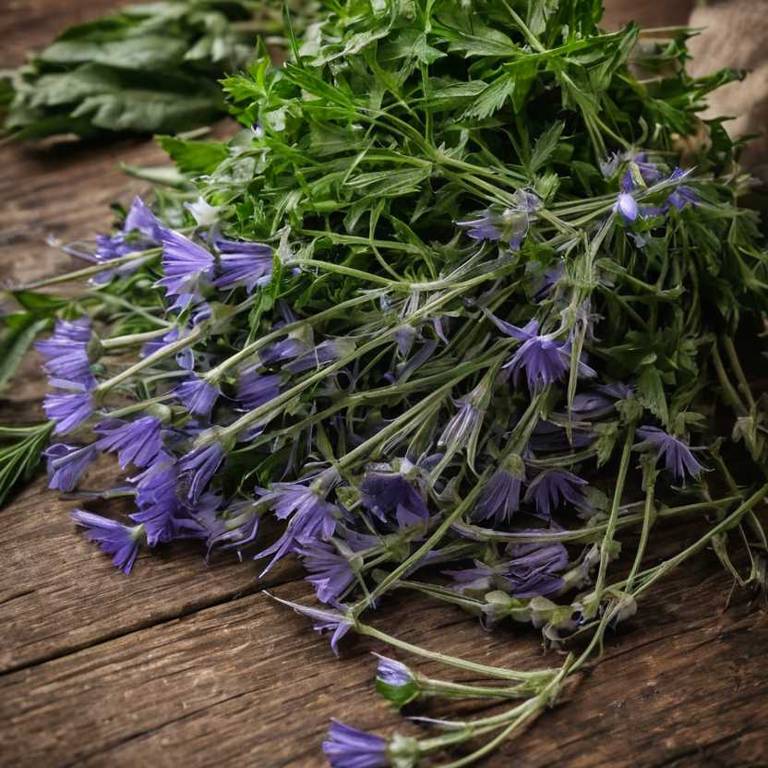By Leen Randell
Updated: Jul 20, 2024
10 Medicinal Constituents Of Cichorium Intybus (Chicory)

Cichorium intybus has active constituents such as flavonoids, phenolic acids, and inulin.
These constituents possess anti-inflammatory, antioxidant, and prebiotic properties, contributing to the plant's medicinal value. Chicory's flavonoids exhibit anti-inflammatory activity, potentially alleviating conditions like arthritis, while its phenolic acids display antimicrobial properties, aiding in wound healing.
The inulin in chicory supports healthy gut bacteria, enhancing digestion and potentially mitigating symptoms of IBS.
This article explains in details the 10 best active constituents of Cichorium intybus.
1. Flavonoids
Cichorium intybus flavonoids is a class of plant compounds that are found in high concentrations in its leaves and flowers.
These bioactive molecules have been extensively studied for their potential health benefits, including antioxidant, anti-inflammatory, and antimicrobial properties.
Flavonoids from Cichorium intybus have also been shown to exhibit estrogenic, cardioprotective, and neuroprotective effects, making them a promising area of research in the fields of nutrition and pharmacology.
2. Luteolin
Cichorium intybus luteolin is a bioactive flavone compound extracted from its leaves and roots.
It has been extensively studied for its various biological activities, including antioxidant, anti-inflammatory, and antimicrobial properties.
Luteolin has been found to exhibit protective effects against oxidative stress, improve cardiovascular health, and even have potential therapeutic benefits in treating certain diseases such as cancer and neurological disorders.
3. Apigenin
Cichorium intybus apigenin is a bioactive flavonoid compound found in its leaves and flowers.
This phenolic compound has been extensively studied for its potential health benefits, including antioxidant, anti-inflammatory, and antimicrobial properties. Apigenin has been shown to possess neuroprotective effects, improve cardiovascular health, and exhibit antiviral activity against certain viruses.
Its bioavailability is relatively high when consumed as a dietary supplement or in food products.
4. Kaempferol
Cichorium intybus kaempferol is a flavonoid glycoside that can be extracted from its leaves and flowers.
This compound has been studied for its potential health benefits, including antioxidant, anti-inflammatory, and antimicrobial properties. Kaempferol has been shown to have protective effects against cancer cells, improve cardiovascular health, and may also possess neuroprotective and immunomodulatory activities.
Further research is needed to fully understand the therapeutic potential of kaempferol from Cichorium intybus.
5. Quercetin
Cichorium intybus quercetin is a flavonoid compound extracted from the plant's leaves and flowers.
It has been extensively studied for its potential health benefits, including anti-inflammatory, antioxidant, and anticancer properties.
Quercetin has been shown to inhibit the growth of cancer cells, reduce inflammation in the body, and protect against oxidative stress, making it a popular ingredient in dietary supplements and natural remedies.
6. Isoflavones
Cichorium intybus isoflavones is a group of plant compounds found in various parts of the plant, including the leaves, stems, and flowers.
These isoflavones have been studied for their potential health benefits, which include anti-inflammatory, antioxidant, and estrogenic properties. They may help to protect against chronic diseases such as cancer, cardiovascular disease, and osteoporosis, and may also exhibit antimicrobial and antiviral activities.
Further research is needed to fully understand the effects of chicory isoflavones on human health.
7. Chlorogenic acid
Cichorium intybus chlorogenic acid is a bioactive compound found in its leaves and roots.
This phenolic acid has been extensively studied for its numerous health benefits, including antioxidant, anti-inflammatory, and antimicrobial properties. It has been shown to possess protective effects against oxidative stress, cardiovascular disease, and certain types of cancer.
Additionally, chlorogenic acid may also help regulate blood sugar levels and improve insulin sensitivity.
8. Caffeoylquinic acid
Cichorium intybus caffeoylquinic acid is a bioactive compound extracted from the roots and leaves of this plant.
It has been extensively studied for its potential health benefits, including antioxidant, anti-inflammatory, and antimicrobial properties.
Caffeoylquinic acid has been shown to have protective effects on liver and kidney function, as well as anti-cancer and anti-diabetic activities, making it a promising area of research in the development of natural therapeutics.
9. Cichoric acid
Cichorium intybus cichoric acid is a bioflavonoid compound found in its leaves and flowers.
It has been traditionally used for its medicinal properties, particularly for its anti-inflammatory and antioxidant effects.
Cichoric acid has been shown to have potent anti-inflammatory activity, which may help alleviate symptoms of conditions such as arthritis and other inflammatory diseases.
10. Flavonoid glycosides
Cichorium intybus flavonoid glycosides is a class of bioactive compounds isolated from its leaves and flowers.
These glycosides are composed of aglycone (flavonoids) linked to carbohydrate moieties, conferring antioxidant, anti-inflammatory, and antimicrobial properties.
They have been shown to exhibit potential therapeutic effects, including cardioprotective, neuroprotective, and anticancer activities, making them a promising area of research for the development of novel pharmaceuticals.